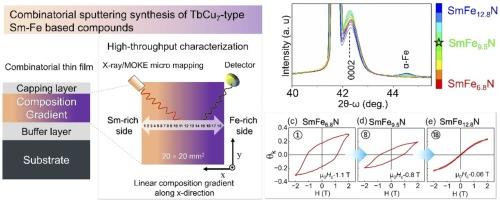Combinatorial sputtering synthesis of TbCu7-type Sm-Fe based compounds: a study on phase, composition, and extrinsic magnetic properties.
IF 5.8
2区 材料科学
Q2 CHEMISTRY, PHYSICAL
引用次数: 0
Abstract
We investigated the effect of composition on the phase and extrinsic magnetic properties of TbCu7-type SmFe-based compounds using combinatorial sputtering technique. Composition-spread thin films of SmFex (x=6.4 to 12.7) and SmFexN (x=6.8 to 12.8) were synthesized using a linear shutter-assisted combinatorial sputtering technique. A high-throughput composition, phase, and magnetic characterization were performed on 18 different locations along the film using X-ray diffraction (XRD), X-ray fluorescence (XRF), and magneto-optical Kerr effect (MOKE) magnetometry. The optimal composition with the highest fraction of the main phase was found to be in SmFe9.8 and SmFe9.5N and beyond this composition, the α-Fe secondary ferromagnetic phase emerges. The coercive field and remanence of the SmFe9.5N is estimated to be ~0.8 T and ~1.2 T respectively. Further, scanning transmission electron microscopy (STEM) was performed at SmFe9.5N to correlate the microstructure with their extrinsic magnetic properties. Overall, this study demonstrates the impact of composition variation on the phase and extrinsic magnetic properties of TbCu7-type SmFe-based compounds, which can be utilized to tailor magnetic properties for targeted advanced magnet applications.

组合溅射合成 TbCu7 型 Sm-Fe 基化合物:关于相、组成和外磁性能的研究。
我们利用组合溅射技术研究了成分对 TbCu7 型 SmFe 基化合物的相位和外磁性能的影响。我们采用线性快门辅助组合溅射技术合成了 SmFex(x=6.4 至 12.7)和 SmFexN(x=6.8 至 12.8)的成分分布薄膜。利用 X 射线衍射 (XRD)、X 射线荧光 (XRF) 和磁光克尔效应 (MOKE) 磁强计对薄膜沿线 18 个不同位置进行了高通量成分、相位和磁性表征。结果发现,SmFe9.8 和 SmFe9.5N 是主相比例最高的最佳成分,超过这一成分,α-Fe 次级铁磁相就会出现。据估计,SmFe9.5N 的矫顽力场和剩磁分别为 ~0.8 T 和 ~1.2 T。此外,还对 SmFe9.5N 进行了扫描透射电子显微镜 (STEM),以将微观结构与它们的外在磁性能联系起来。总之,这项研究证明了成分变化对 TbCu7 型 SmFe 基化合物的相和外磁性能的影响,可用于定制磁性能,以实现有针对性的先进磁体应用。
本文章由计算机程序翻译,如有差异,请以英文原文为准。
求助全文
约1分钟内获得全文
求助全文
来源期刊

Journal of Alloys and Compounds
工程技术-材料科学:综合
CiteScore
11.10
自引率
14.50%
发文量
5146
审稿时长
67 days
期刊介绍:
The Journal of Alloys and Compounds is intended to serve as an international medium for the publication of work on solid materials comprising compounds as well as alloys. Its great strength lies in the diversity of discipline which it encompasses, drawing together results from materials science, solid-state chemistry and physics.
 求助内容:
求助内容: 应助结果提醒方式:
应助结果提醒方式:


